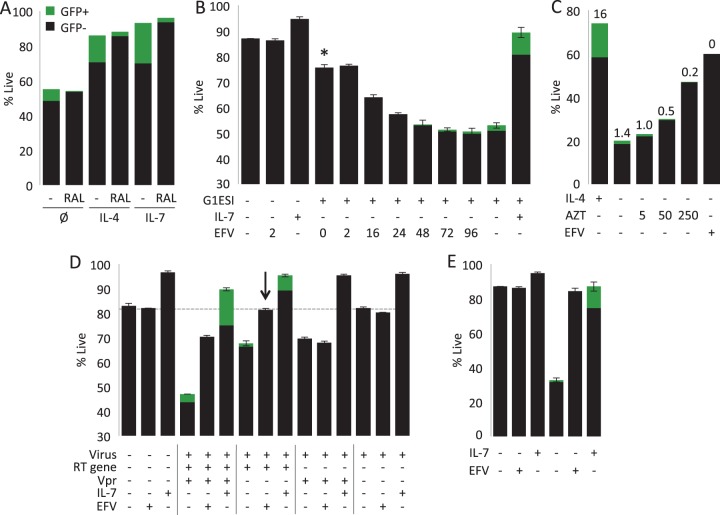FIG 6.
Early HIV-1-induced death of resting peripheral blood T cells results from the additive effects of reverse transcription and virion-borne Vpr. (A) Effect of raltegravir on cell death. CD4 T cells were infected with GFP reporter virus in the presence or absence of raltegravir (1 μM) and with or without IL-4 or IL-7 treatment. Data were collected 6 days postinfection. Ø, no interleukin. (B) Stacked bar graph combines GFP expression (green) and cell viability (total bar height) assessed 6 days after infection. CD4 T cells were infected with the single-round GFP reporter virus or mock infected (centrifuged with no virus). At the indicated times relative to infection, the nonnucleoside RT inhibitor efavirenz (EFV) was added. Where indicated, IL-7 was added on the day of infection. The asterisk indicates the addition of EFV 24 h after infection. (C) Effects of AZT (indicated micromolar concentrations) and EFV (3 μM) on survival and GFP expression. Numbers above bars indicate the percent GFP+. (D) Independent and additive contributions of virion Vpr and reverse transcription to cell death. Cells were infected with a virus that expresses all HIV-1 proteins except Envelope or with mutant viruses that do not express either Vpr or an active reverse transcriptase or both. In each case, cells were treated or not with EFV or IL-7. Stacked bar graph combines GFP expression and cell viability assessed 6 days after infection. Panels A and B show results from one representative experiment of 3. Data are averages from 3 independent infections performed in the same experiment. The arrow indicates that the addition of EFV completely prevented all cell death induced by this virus. (E) Vpr-independent killing is protected by EFV at a high multiplicity of infection. Survival experiment equivalent to that shown in Fig. 3B using 3 times the dose of the NLHGESI ΔVpr virus.

